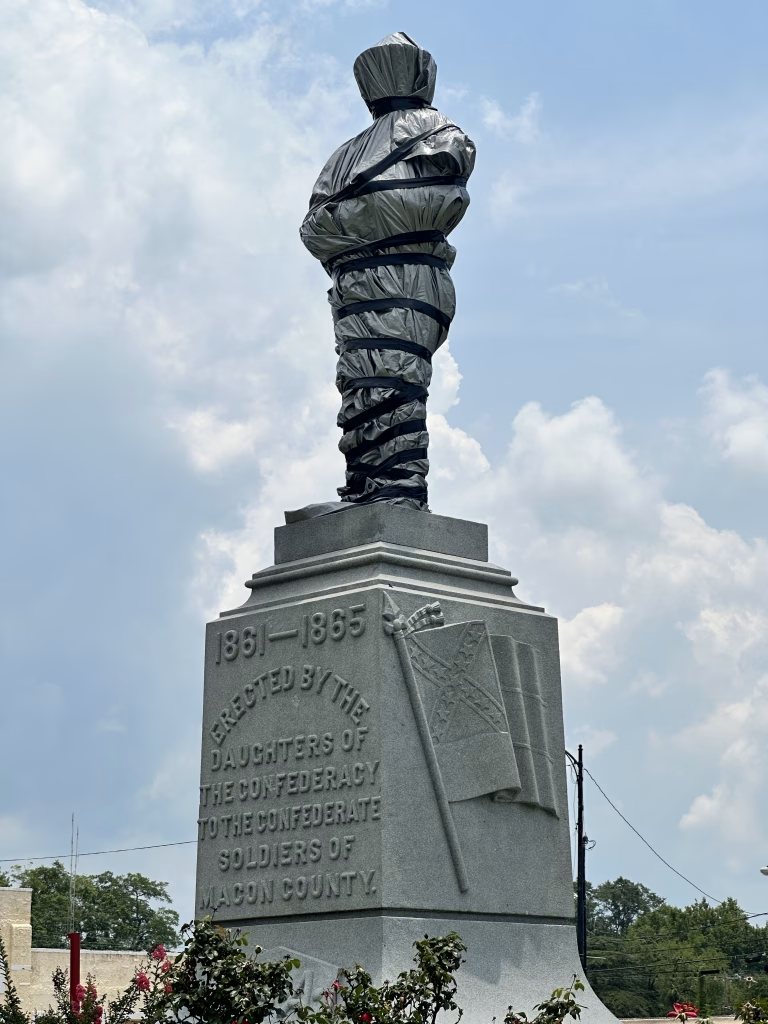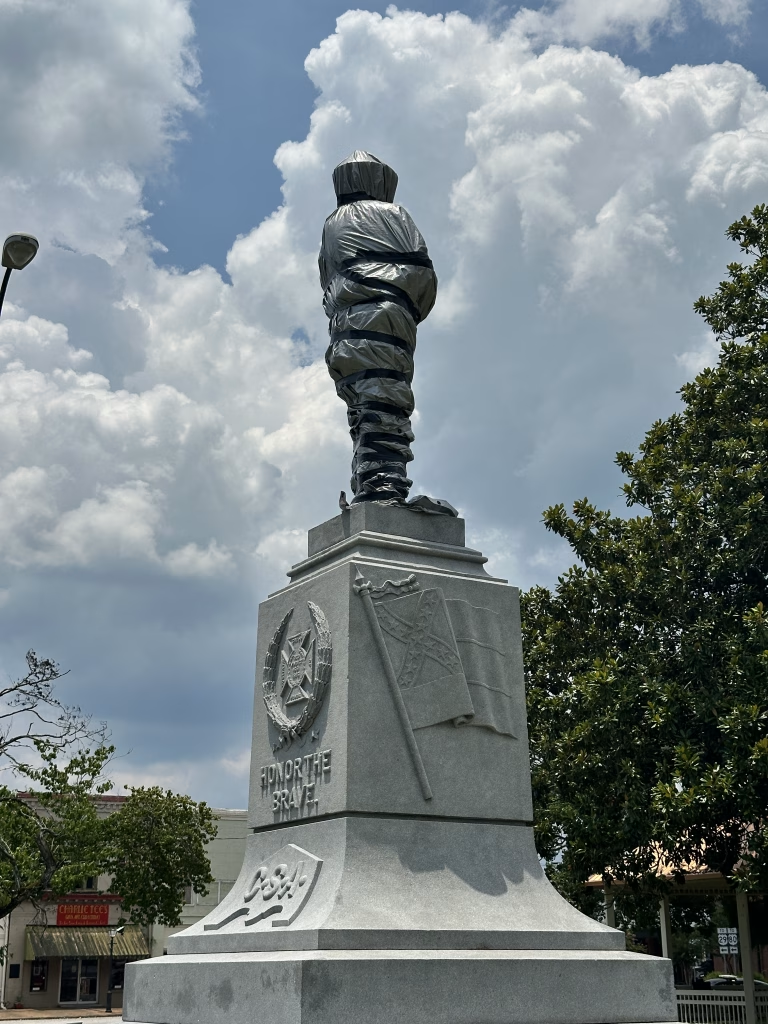Earlier this week, I had cause to visit Tuskegee University, which also led me to a brief drive to the town square, where I saw something not uncommon in the town squares of small Alabama towns, especially county seats (Tuskegee* is the county seat of Macon County). That something was a CSA war memorial placed there by the United Daughters of the Confederacy in 1909.
I was struck less by the presence of the statue, although its physical proximity to one of the nation’s premier HBCUs was jarring in and of itself. I was struck by its physical state, which led me to get out of my car and take a picture (several, in fact). Here are two.


Note the inscriptions and the fact that the figure is tarped and taped in a manner that certain geeks might think looks like the mummies in the classic Doctor Who serial, “The Pyramids of Mars.”
My first reaction was: I guess that is how you deal with a CSA Memorial that state law forbids you from removing.
Upon doing a little research after having returned home, it seemed that maybe it was finally being prepared for removal (more on that below).
Both are guesses, I will confess, as I cannot find a news story about the statue that is more recent than January of 2023.
Still, the very presence of the monument is noteworthy.
Before I get to the most recent news developments about this specific statue, let me note the following.
Macon County, AL is just to the east of Montgomery County and has a current estimated population of ~18,000, with 79.1% of the county population being Black (source). The city of Tuskegee holds ~8,000 of those persons, and 85% of the population of Tuskegee is Black (source).
It is worth noting that in 1888, according to one source, the percentage of the country that was Black was ~74%. Macon County is in the Black Belt (see here for more on that) and was once home to substantial cotton farming, which utilized slave labor. The total population in 1888 was ~17,000.
Going back even further to 1860, the US Census recorded 18,176 enslaved persons in the county, ranking it 7th in the state and 15th in the country (source).
All of these numbers are remarkably similar over a roughly 165-year period, which correctly suggests that the county has never had any significant economic development, save for the presence of Tuskegee University itself (although there was some growth surrounding the era of the Tuskegee Airmen and the subsequent decline).** It is also rather impossible to ignore that the current demographics of the county are rather clearly linked to the economic and social structures of the 19th Century. To be as direct as one can: you can’t look at Macon County and not see how slavery shaped the place, even over a century and a half later.
Moreover, this is hardly limited to Macon County or the state of Alabama. This observation seems relevant to any number of contemporary conversations about race and politics in America, even if one finds oneself allergic to certain three-letter combinations (be they CRT or DEI or whatever the next one may be).*** I am reminded of the famous line from Faulkner, “The past is never dead. It’s not even past,” as well as the cliche that those who refuse to learn the lessons of history are doomed to repeat them.
We so clearly refuse, as a country, to acknowledge how the past continues to shape the present. And pretending like all we need to know is some combination of nostalgia-fueled understandings of our own biographies, coupled with simplistic Great Man history lessons, is enough to understand ourselves is simply foolishness.
Having set those numbers down, let’s talk about the statue. In 1906, the Macon County government gave space to the United Daughters of the Confederacy in downtown Tuskegee for the creation of a park, which would have a Confederate Memorial in its center. The park was to be designated Whites Only. Wikipedia notes that in 1906, the city was 82% Black (I have not corroborated that numbers, but it so closely comports with what I found from the 1800s and the present period that I see no need for further confirmation).
Back in January of 2023, over two years ago, the AP reported: Ruling paves the way to remove Tuskegee Confederate statue.
An Alabama judge has paved the way for officials to remove a Confederate monument placed a century ago at the center of a historic, majority-Black city as part of a “park for white people.”
[…]
Circuit Judge Steven Perryman on Thursday ruled that the site should revert to the Macon County Commission under the terms of a 1906 deed that gave the space to the Tuskegee Chapter of the United Daughters of the Confederacy for the purpose of “maintaining a park for white people and maintaining a monument to the memory of the Confederate soldiers.” Perryman said there was no evidence the space had been maintained as a segregated park so the land should revert to the county under deed terms that said the county would get the land back if it wasn’t used for those purposes.
The judge gave the Tuskegee Chapter of the United Daughters of the Confederacy 60 days to retrieve and remove the monument. The group could appeal the ruling.
It strikes me as quite significant to note the very specific history of this square, its purpose, and the general politics of both Macon County and Alabama in general. It is ironic that the way around state law is to weaponize the original purpose of the square against it.
Some additional thoughts.
First, despite all the claims that these statues are just about honoring war dead and/or just celebrating “heritage,” it is quite clear that this was about white supremacy. The easy tip-off, in case it needs pointing out, is the fact that the square was supposed to be for Whites only. Indeed, it technically still is, even if those rules were never enforced.
Second, as noted above, the county and the city were both overwhelmingly Black over its history, and yet the government was dominated by Whites (I think it is fair to infer, although I did not directly confirm, that the Macon County government that gave this space to UDC for a “whites only park” was controlled by Whites). We know that Blacks were substantially disenfranchised in Alabama in 1906 when the land was given to the UDC. Indeed, such disenfranchisement was evident for decades. Note, for example, an important civil rights case from 1960, Gomillion v. Lightfoot, dealt with racial gerrymandering in Tuskegee.
Third, to look to contemporary politics, forcing an overwhelmingly Black town and county to keep a CSA statue in its town square is not some act of honoring history; it is an act of dominance.
From an AP piece in 2021:
Rep. Mike Holmes of Wetumpka filed a bill in the current session that would increase the fine from a flat $25,000 to $10,000 a day. Holmes voted against Givan’s bill, saying it would weaken protections for the monuments.
“It has nothing to do with race. It has to do with history,” Holmes said. He added that a large part of the state has ancestors who lost their lives in the Civil War.
Asked by a Montgomery Advertiser reporter about the feelings of slave descendants, Holmes disputed that the Civil War was about slavery and white supremacy.
“Do you have any proof of that?… There is no proof of that.” Holmes replied.
As a matter of fact, yes, there is a lot of proof of that. To quote a post I wrote in 2015:
Just to remind everyone of what Vice President (of the CSA) Stephens said:
The new constitution has put at rest, forever, all the agitating questions relating to our peculiar institution — African slavery as it exists amongst us — the proper status of the negro in our form of civilization. This was the immediate cause of the late rupture and present revolution.
Or, the state of Mississippi: “Our position is thoroughly identified with the institution of slavery– the greatest material interest of the world.”
The declaration of secession by South Carolina lacks a simple sentence as clear as the one above, but the entire documents is a narrative about the tension between slaveholding and non-slaveholding states. As such, the state’s motivation could not be clearer. This is likewise true of the Texas declaration, which criticizes the northern state for trying to “steal our slaves” among other things. Virginia’s (which is brief) speaks of the “oppression of the Southern Slaveholding States.”
It takes an act of utter self-delusion, or outright untruth, to assert that the war was not about maintaining slavery and white supremacy.
Like I have written many times before (for example, but not limited to, here, here, and here), America is not willing to face up to its own history, and that is why we continue to struggle in the now with these issues.
In conclusion, if I were to offer a bit of grace to those who claim that these statues are needed so that we can be reminded of our history and heritage, I would have to admit that this specific statue led me to examine quite a bit of history and the heritage that it reflects. It just isn’t the history that the United Daughters of the Confederacy wish to pretend existed. Or, perhaps more accurately, all of this just underscores the ugly history and heritage the UDC is really praising, which is one of white supremacy and injustice.
*It seems worth noting that the name of the place derives from the Muskogee word for warrior, Taskeke. This helps illustrate the deeper indigenous history of the region, which is often forgotten or, at least, underplayed.
**For a more detailed discussion of the history of the population of the city of Tuskegee and Macon County, see Foster Dickson, Tuskegee, Before and After.
**For example, this story was on the front page of WBHM as I was writing this post: Federal judge weighs whether Alabama’s anti-DEI law threatens First Amendment. It seems noteworthy that one of the “divisive concepts” under attack is that of “systematic racism.”
Click this link for the original source of this article.
Author: Steven L. Taylor
This content is courtesy of, and owned and copyrighted by, https://www.outsidethebeltway.com and its author. This content is made available by use of the public RSS feed offered by the host site and is used for educational purposes only. If you are the author or represent the host site and would like this content removed now and in the future, please contact USSANews.com using the email address in the Contact page found in the website menu.







